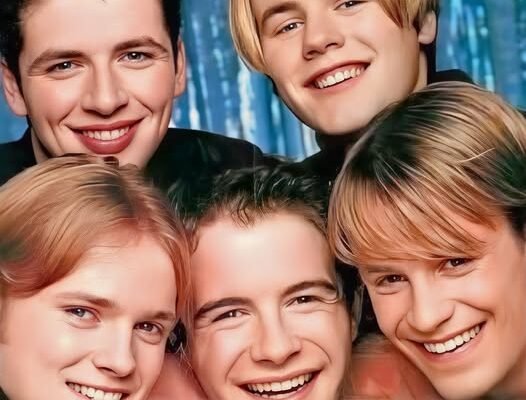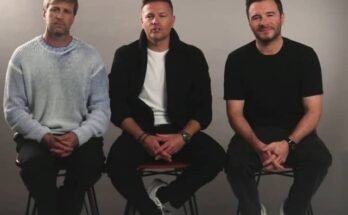For anyone growing up in the late ’90s and early 2000s, Westlife wasn’t just a band — they were the band. They were the soundtrack to our heartbreaks, the stars of our bedroom posters, and the topic of countless schoolyard conversations. Long before streaming and social media transformed how we discover and obsess over music, Westlife had already etched themselves into our hearts with perfectly harmonized ballads, coordinated outfits, and that distinctly Irish charm.
They weren’t just pop idols — they were our childhood crushes.
The Rise of Westlife: More Than Just a Boyband
Westlife was formed in 1998 in Sligo and Dublin, Ireland. The original lineup — Shane Filan, Mark Feehily, Kian Egan, Nicky Byrne, and Brian McFadden — had a rare chemistry that helped them stand out in the golden era of boybands. Managed by music mogul Louis Walsh and later mentored by Simon Cowell, they quickly became a force to be reckoned with. Their debut single “Swear It Again” rocketed to number one in the UK charts, and from there, their success was meteoric.
In a time before TikTok dances and viral trends, Westlife ruled the charts the old-fashioned way — with talent, relentless touring, and a deep emotional connection with their fans.
The Songs That Defined Our Youth
Westlife’s music was an emotional rollercoaster. Whether you were 10 or 16, there was a Westlife song that seemed to understand exactly what you were going through.
- “Flying Without Wings” wasn’t just a ballad; it was the anthem of the early 2000s. Sung at school assemblies, weddings, and karaoke nights, it gave us goosebumps and a sense that love — pure, selfless love — was waiting somewhere out there.
- “My Love” was the song you played on repeat when someone moved away or when your crush didn’t like you back. That soaring chorus gave comfort and catharsis.
- “If I Let You Go” captured the agony of indecision and heartbreak, something we might not have fully understood at the time, but deeply felt all the same.
And of course, their countless covers — “Uptown Girl,” “You Raise Me Up,” and “Mandy” — gave new life to classic hits, making them relevant to a new generation. Every song came with a dramatic key change and a perfectly timed stool stand, and we loved them all the more for it.
Why We Fell in Love With Them
Ask any fan what made Westlife crush-worthy, and they’ll say it wasn’t just the looks (although those definitely helped). Each member had a distinct personality and appeal:
- Shane was the romantic lead, the emotional vocalist whose voice could melt anyone.
- Mark, quietly charismatic and deeply soulful, added emotional depth and mystery.
- Kian was the cheeky one — fun, approachable, and full of energy.
- Nicky, with his charming smile and boy-next-door appeal, felt like someone you’d bump into at a local coffee shop.
- Brian (before his departure in 2004) was the wildcard, the one with a bit of edge.
They weren’t overly polished or unattainably perfect — they felt real. They were your ideal boyfriend, your best friend, your biggest fantasy all rolled into one.
Posters, Scrapbooks, and Teen Dreams
For many of us, being a Westlife fan was more than just listening to their CDs (which we probably played on a chunky portable player or boombox). It was an entire lifestyle.
We hung posters on our walls, plastered with glossy images torn from teen magazines like Smash Hits, Top of the Pops, and Mizz. We made scrapbooks with song lyrics, concert photos, and quotes. We learned to doodle their names with hearts in our school notebooks, and we memorized their birthdays like they were national holidays.
Some fans wrote letters to them, others queued for hours to meet them at signings. And when they performed on TV — whether it was “Top of the Pops” or a Christmas special — we gathered around the screen like it was a sacred ritual.
When Brian Left — And We Cried
In 2004, when Brian McFadden announced he was leaving the band to spend more time with his family, it felt like the end of an era. There was heartbreak and confusion, but also a maturity in how the remaining members handled it. They didn’t implode or lash out. They carried on — gracefully, with the same emotional sincerity they were known for.
That moment marked the first time many of us confronted the idea that things change, even things you think will last forever.
Growing Up With Westlife
As we got older, so did Westlife — and their music grew with us. Their songs started to touch on themes of resilience, reflection, and adulthood. While other bands split up or faded into irrelevance, Westlife adapted. Even during their hiatus from 2012 to 2018, the loyalty of their fanbase never wavered.
Their comeback in 2018 with “Hello My Love” was met with pure nostalgia and excitement. Suddenly, we were adults again, with jobs and bills — but when Westlife sang, we were kids once more, hearts racing, eyes gleaming with the thrill of first love.
Legacy of a Generation
In the age of hyper-digital fandoms and algorithm-curated music, Westlife stands as a reminder of simpler times. Of mixtapes made from radio recordings. Of lining up for CDs. Of writing letters to pop stars who made us feel seen.
They weren’t just our first musical obsession — they were a formative experience. They taught us about love, heartbreak, friendship, and loyalty. They showed us what it means to wear your heart on your sleeve.
So when we say that Westlife were our childhood crushes, we’re not just talking about posters and daydreams. We’re talking about a deep, emotional connection that shaped our adolescence. They were the voice of our coming-of-age, and they will forever hold a sacred place in our hearts.
Because no matter how old we get, the opening chords of “Flying Without Wings” will always make us feel like we’re 13 again — clutching a hairbrush microphone, believing in love, and crushing on Westlife.



